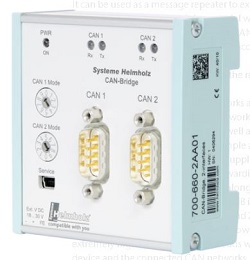Back

CAN to CAN Bridge
Part No: 700-660-2AA01
.
CAN Bus to CAN Bus bridge of two networks
It can be used as a message repeater to expand network distances, as well as to connect different CAN networks together. It is immaterial whether the CAN networks have different transfer rates or work with different protocols, such as CANopenŽ and a proprietary protocol.
A flexibly adjustable filtering logic can accept freely selectable identifiers and transfer them to the other network.
The CAN messages are forwarded to the respective other CAN network according to the store-forward principle and sent out again.
With the CAN bridge, the CAN networks are physically decoupled (electrical isolation) and the bus load is reduced on both CAN networks. The CAN bridge allows a flexible design of the network topology; star and tree structures as well as extensive line structures can be implemented. The CAN bridge can be configured for simple applications using the two rotary coding switches.
For more complex applications, the supplied CAN bridge parameterization software can be used to flexibly adjust the filtering and forwarding of CAN telegrams.
Up to 256 range filters are available, along with up to 4 bit filters for address filtering. The configuration is imported through a USB interface and can also be read out again.
The CAN bridge works both in 11-bit and 29-bit mode, and can communicate with transmission rates from 10 kbps to 1 Mbps. It has a powerful microcontroller that can operate even with extremely high data rates and bus loads without loss of messages. 5 LEDs indicate the status of the device and the connected CAN networks.
- Enlargement of the network scope
- Connect different CAN networks (different transmission rates / different protocols)
- Physical disconnection (electrical isolation)
- Reduced bus load on both CAN networks
- Automatic detection of transmission rates
- Easy configuration mode
- For use with CAN 2.0A & 2.0B, CANopenŽ, DeviceNet, SAE J1939
- DIN rail mounting